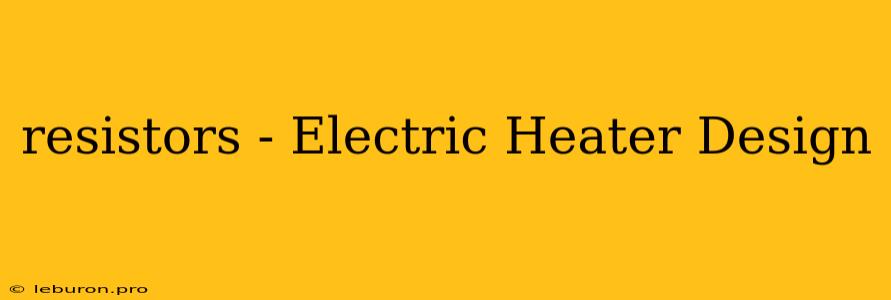The design of electric heaters hinges on the fundamental principle of converting electrical energy into heat energy. This conversion process is primarily driven by the use of resistors, which are essential components that play a crucial role in determining the heater's performance and efficiency. Resistors act as electrical resistance, hindering the flow of current and causing the dissipation of energy in the form of heat. This article will delve into the intricate relationship between resistors and electric heater design, exploring the key considerations, calculations, and factors that influence the selection and application of resistors in these heating systems.
Resistors: The Heart of Electric Heaters
At the core of every electric heater lies a network of resistors, meticulously chosen to achieve the desired heating output. These resistors are essentially electrical components designed to impede the flow of current, leading to energy dissipation as heat. The amount of heat generated by a resistor is directly proportional to the square of the current flowing through it and its resistance value. This fundamental relationship forms the basis for understanding the role of resistors in electric heater design.
Resistor Types and Their Applications
Electric heaters employ a variety of resistors based on the specific requirements of the application. The most common types of resistors used in electric heater design include:
- Wirewound Resistors: These resistors consist of a wire coil wound around an insulating core. They offer high power ratings and are commonly used in industrial heaters, water heaters, and space heaters.
- Thick Film Resistors: These resistors are fabricated on a ceramic substrate using a conductive paste. They offer high resistance values and are suitable for low-power applications in small-scale heaters.
- Thin Film Resistors: Similar to thick film resistors, these resistors utilize thin films of conductive material deposited on a ceramic substrate. They provide high precision and stability, making them suitable for high-performance heating applications.
- Carbon Film Resistors: These resistors are made by coating a ceramic core with a thin layer of carbon. They offer a balance between cost and performance, finding applications in general-purpose heating systems.
Calculating Resistor Values for Electric Heater Design
Determining the appropriate resistor value for an electric heater is a critical aspect of the design process. This calculation depends on factors such as the desired heating power output, the supply voltage, and the intended application. The key formula used to calculate the resistor value is:
R = V^2 / P
where:
- R is the resistor value in ohms
- V is the supply voltage in volts
- P is the desired power output in watts
For instance, to design an electric heater with a power output of 1000 watts operating at 240 volts, the required resistor value would be:
R = (240)^2 / 1000 = 57.6 ohms
This calculation serves as a starting point for selecting a suitable resistor for the heater design. However, it's important to consider other factors such as the resistor's power rating, temperature coefficient, and tolerance to ensure proper operation and safety.
Resistor Power Rating and Heat Dissipation
The power rating of a resistor refers to the maximum amount of power it can safely dissipate without overheating or failing. Exceeding the power rating can lead to resistor damage and potential fire hazards. It's crucial to select resistors with power ratings that are significantly higher than the expected power dissipation in the heater.
Heat dissipation is a critical concern in electric heater design. Resistors generate heat as they resist the flow of current, and this heat needs to be effectively transferred to the surrounding environment. The choice of resistor material, the design of the heater enclosure, and the presence of cooling mechanisms all influence the heat dissipation process.
Temperature Coefficient and Stability of Resistors
The temperature coefficient of a resistor indicates how its resistance value changes with temperature. Some resistors exhibit a positive temperature coefficient, meaning their resistance increases with temperature, while others have a negative temperature coefficient, leading to a decrease in resistance with temperature. The temperature coefficient needs to be considered to ensure stable operation of the heater.
Resistors in Various Electric Heater Types
Resistors find widespread use in a variety of electric heater designs, including:
- Space Heaters: These heaters utilize resistors to generate heat that warms the air in a room or enclosed space. The choice of resistor type and power rating depends on the desired heating capacity and the size of the space.
- Water Heaters: Resistors are essential components in water heaters, where they heat the water flowing through a tank or pipe. The resistors are typically submerged in water and designed to withstand high temperatures and corrosion.
- Industrial Heaters: Industrial heaters often employ high-power resistors to generate heat for industrial processes such as drying, curing, and melting. These resistors must be robust and able to handle demanding operating conditions.
Conclusion
Resistors are fundamental components in electric heater design, responsible for converting electrical energy into heat energy. Understanding the properties and characteristics of resistors, including their types, power rating, temperature coefficient, and heat dissipation capabilities, is crucial for optimizing heater performance and efficiency. By carefully selecting and applying resistors in accordance with design requirements, engineers can create safe, reliable, and effective electric heaters for a wide range of applications. The use of resistors in electric heaters underscores the importance of these components in modern heating technologies, enabling the conversion of electrical energy into valuable heat energy for diverse applications.
